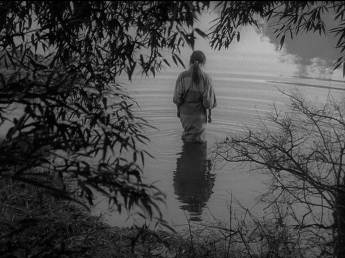Sitting in the archives at this very moment are hundreds, if not thousands, of one- and two-reel silent comedies. At one time, these slapsticks were presumed the only silents worth excavating—the lone unembarrassing artifacts of a primitive, prepubescent era. The comedies found their praises sung by every film expert from James Agee to Jim Broughton. No less than the head of UCLA’s film school declared the “Obsolescence of the Silent Film” and dared his readers to “[t]ry to see, if you can, any silent film—except a comedy with Charlie Chaplin or Harold Lloyd, Raymond Griffith or Buster Keaton, Harry Langdon or Laurel and Hardy—and you will wonder why people thought it at all bearable, let alone great.”
The scales have shifted since—not least through our perpetual acquaintance with these films on 16mm and 8mm. (Dig through any film collector’s basement and it won’t be long till you find a dupe or two or three of Easy Street or Cops.) It’s the discoveries—the once “presumed lost” titles from studios not usually known for comedies—that really strain. Run two or three of them back-to-back and let the derangement begin. (May I suggest His Baby Doll and The Camera Cure, both Triangles from 1917?) Try to remember where one ends and the next begins. Slap another title on the head and you can barely tell the difference. It all feels vaguely second-hand, if not plagiarized, but from what?
Take two steps back, and patterns emerge. You can’t follow the plot, but you notice how overstuffed everything is. Silent comedies propose an infinite supply of bodies, always another available to jam into a cramped room or fling at the end of a line. There are always more than necessary for a gag to come off, buzzing with a negative, supposedly manic, energy in the background. The more the funnier. One cannot help but stumble away with the conclusion that human life and labor are cheap.
Even in the major productions, the essential and awesome interchangeability of parts and persons, especially women, is evident. What does Merna Kennedy have that Marion Mack does not? Fact is, Chaplin, Keaton, and Lloyd rarely cast actresses who provided any serious competition as personalities. These days, I find myself admiring the production values in their features much more readily than the underlying dynamics and routines.
The gratifying exception is, not coincidentally, a Lloyd talkie—Movie Crazy (1932), surely his best talkie and probably his best film overall. Watching Lloyd—nearly forty and, what’s more, always a businessman first and a comedian second—play a fan magazine-addled yokel inspires incredulous mirth all on its own. His on-screen partner, Constance Cummings, is something else—a real and ambitious actress who ably develops her own characterizations independent of his foibles. She’s quicker than he is, constantly and consciously evaluating her allegiances, scheming and then finding herself dangerously unprepared for the spoils. It’s a fully-formed personality and a performance that actively repudiates the perfunctory history of her predecessors.
Cummings even negotiates something of a dual role—up-and-coming actress Mary Sears (sufficiently up to afford a colored maid and coming enough to have a modest mansion) and her on-set alter ego, a ridiculous imitation of a Mexican love interest. (Part of the pleasure of Cummings’s performance comes from her self-awareness and punk insouciance as regards this ethnic theater.) That Lloyd’s Harold Hall cannot recognize the two women as one suggests some indigenous melting pot calamity, as well as, incidentally, a kind of That Obscure Object of Desire in reverse.
Indeed, a Buñuelian air hangs over the whole picture, from the remarkably blank non-performances of Lloyd’s parents (veteran character players De Witt Jennings and Lucy Beaumont, dead-eyed and serious, devoid of any mugging) to the repetition of certain elements (doves, broken glass) which forfeit their efficiency as gags until they loom as Surrealist totems. Palm trees line every alleyway in Harold’s sunny Hollywood and screen tests speed themselves up to mock the innocent.
Clyde Bruckman plays the credited director, though he was purportedly too drunk to helm the show most days, with Lloyd taking over his duties. (Nevertheless, a pesky auteurist question: how can the man who signed The General, Movie Crazy, and The Man on the Flying Trapeze be regarded as a footnote to his own career?) Either way, Movie Crazy is intermittently, impressively (accidentally?) fluid. There are five or six very elaborate tracking shots here that burrow their way straight ahead with conspicuous and casual professionalism. They’re like nothing else in Lloyd’s work—or Bruckman’s.
As in Lloyd’s previous effort, Feet First, a loose reworking of Safety Last that illustrated how sound and its naturalism automatically confers on any situation qualities of starkness and violence that silence muted, Movie Crazy abounds in harsh, flat sound effects: the crumbling of a straw hat, the screeching of a revolving coat rack. There may be more sound than talk. This is a crudity that is resilient and resplendent.
Cross-posted at the Northwest Chicago Film Society blog.
